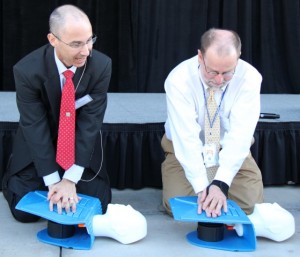 If you’re a regular reader, you know how much value I place on using data to decide if interventions are successful and then sharing successful interventions with others. The way we helped change to hands-only CPR is a great example. We used evidence to craft our intervention (modifying how CPR is done), measured its effectiveness, and published the results. Now, most of the country and some of the world is shifting to the new CPR.
If you’re a regular reader, you know how much value I place on using data to decide if interventions are successful and then sharing successful interventions with others. The way we helped change to hands-only CPR is a great example. We used evidence to craft our intervention (modifying how CPR is done), measured its effectiveness, and published the results. Now, most of the country and some of the world is shifting to the new CPR.
Dr. Ben Bobrow (our EMS Medical Director) bounded into my office about a year ago with a similar idea to train 911 dispatchers to coach callers through CPR instructions more effectively. We cobbled together the money from some voter initiative funds, and our ADHS Telephone-Assisted CPR program was born. Of course, we built measurement into the front end, and the results showed that we’ve almost cut in half the time it takes for 911 callers to start CPR. That’s real important- because survival drops by 10% for every minute delay in starting CPR- and the typical wait time for an ambulance is 5-8 minutes.
Now that successful program is going international. One of the Clinton Global Initiative meetings this week in St. Louis highlighted our dispatch training initiative as a scalable evidence-based best-practice with a high return on investment. Basically, it’s quickly becoming a global model for saving lives. In fact, the Global Dispatch CPR Intervention is already underway in 10 countries in Asia (including Singapore this week)… and will last about 3 years, focusing on Asia, the Middle East and North America.










Hope we have same high quality service and performance in Turkey at the future. Local connections are very important and we dont have this.